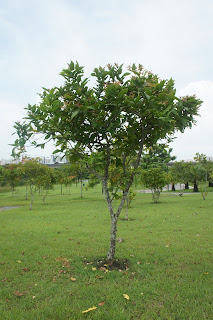Commonly known as Sweet Tamarind, the origins of this tree is unknown but is generally believed to be native to Africa.
The Tamarind tree is a large, evergreen tree that can grow up to 30m tall. It has a bushy, irregularly-shaped crown. It has greyish brown bark that is rough and fissured. The heartwood is red in colour while the sapwood is yellow. The alternate, pinnate leaves are bright green in colour and elliptic in shape. The petiole and rachis are finely haired with yellow hairs. Stipules present fall off very early. The leaflets close up at nighttime.
The flowers are inconspicuous and pale yellow or pink in colour. They are about 2.5cm wide, have 4 sepals and 5 petals. The upper 3 petals are well developed while the lower 2 are smaller and have orange or red streaks. Flower buds are pink as the sepals are and fall off when the flower blooms.
The fruit os the Tamarind tree is an indehiscent pod about 12 to 15cm long. It has a rusty brown shell that is somewhat brittle. The pods contain seeds that are embedded in a sticky edible pulp. Each pod contains about 3 to 12 1.5cm long seeds. The seeds are irregularly shaped, shiny, and smooth. The reddish dark brown pulp is fleshy and sour pulp. The taste of the tamarind is sweet and sour at the same time.









.JPG)







































